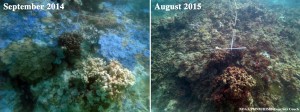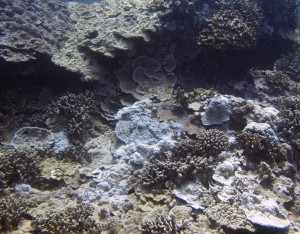Water Temperature Rise Leads to Coral Bleaching
The effects of coral bleaching now span all of Hawai’i, from the Kure Atoll to the northernmost land feature in the Hawai’i Archipelago, according to the Department of Land and Natural Resources.
According to climate experts with the National Oceanic and Atmospheric Administration’s Coral Reef Watch program, they have forecasted severe coral bleaching conditions for Hawaiian waters beginning in August and continuing through October. The expected severe conditions are due to coral sensitivity which begins with ocean temperature increases as small as one to two degrees.
High ocean temperatures caused of El Nino bring the likelihood of causing mass coral bleaching across Hawai’i, according to the DLNR, who says that last summer, the first documented event of mass bleaching across the entire archipelago took place. Reefs in the Northwestern Hawaiian Islands also experienced their third, and worst, reported mass bleaching event to date.
“Coral bleaching is a result of a loss of algae living within the coral’s tissue that provide them with energy and give them their colors. This loss results in the pale or white ‘bleached’ appearance of the impacted corals. When corals bleach, they lose a supply of energy and become particularly vulnerable to additional environmental stresses,” said Brian Neilson, an aquatic biologist with the DLNR Division of Aquatic Resources.
In some areas, coral bleaching has already begun. Scientists, along with members of the public, have already noted the bleaching in areas that were impacted by last year’s event, like in Kaneohe Bay on Oahu.
“Some corals in Kaneohe Bay are already visibly pale or white, reflecting the detrimental impacts of unseasonably high seawater temperatures that we have been experiencing,” Dr. Ruth Gates, director of the Hawai’i Institute of Marine Biology observed.
After the NWHI were affected by coral bleaching in 2014, a NOAA research cruise from Papahânaumokuâkea Marine National Monument noted that some signs of recovery in the area had been seen.
“We did see signs of recovery of corals in certain places,” said Courtney Couch, Ph.D., a researcher with HIMB who recently revisited sites affected in the NWHI to assess coral mortality and recovery from last year. “But at certain sites that experienced the most severe coral bleaching, we found that 85 to 100 percent of the corals have died. This is especially concerning since these sites are home to some of the most unique and rare coral species.”
Some of the concerns of corals dying from bleaching comes from the degraded reefs who provide shoreline protection, as well as the availability of habitat for fish and other marine species. These things impact ocean-related businesses and tourism, the availability of fish, and the quality of life for humans, according to the DLNR.
Although corals can recover from bleaching, they can also die if bleaching occurs for prolonged periods of time. Algae can slow the recovery of the coral reef. In response, DLNR has begun to mobilize monitoring surveys and meeting with partners across the state to devise coordinated response actions.
“Being extra careful to not damage corals, preventing pollution inputs, and using pono fishing practices can help corals to recover from this bleaching event,” according to DLNR Chair Suzanne Case.
Despite the mortality of bleached corals in the NWHI, NOAA Superintendent for Papahânaumokuâkea Marine National Monument Athline Clark remains hopeful that the reefs will repopulate.
“With the Monument’s fishing restrictions and healthy herbivore populations [fish and other animals that keep algae in check], there’s hope that reefs in the NWHI will repopulate. The NWHI serves as a natural reference site to help us to understand how reefs that are not exposed to human influences can possibly recover faster than those in the populated islands of our archipelago,” Clark said.
Members of the public can report and help document coral bleaching across the state through the Eyes of the Reef Network. Images can be sent to [email protected].
“If we fail to protect them and lose them, it could have tremendously negative impacts not only on the overall ocean ecosystem but on Hawai’i’s economy,” Case said.















